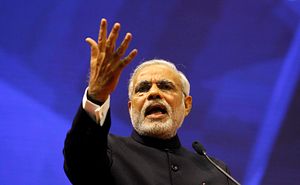NEW DELHI – After a prolonged period of political drift and paralysis, India’s new government will be led by a man known for his decisiveness. Just as Japanese Prime Minister Shinzo Abe’s return to power in late 2012, after six years of political instability, reflected Japan’s determination to reinvent itself as a more competitive and confident country, Narendra Modi’s election victory reflects Indians’ desire for a dynamic, assertive leader to help revitalize their country’s economy and security.
Like Abe, Modi is expected to focus on reviving India’s economic fortunes while simultaneously bolstering its defenses and strengthening its strategic partnerships with likeminded states, thereby promoting regional stability and blocking the rise of a Sino-centric Asia. The charismatic Modi – a darling of business leaders at home and abroad – has promised to restore rapid economic growth, saying there should be “no red tape, only red carpet” for investors.
The 63-year-old Modi mirrors Abe’s soft nationalism, market-oriented economics, and new Asianism, seeking close ties with Asian democracies to create a web of interlocking strategic partnerships.
In a country where the gap between the average age of political leaders and citizens is one of the world’s widest, Modi will be the first prime minister born after India gained independence in 1947. This constitutes another parallel with Abe, who is Japan’s first prime minister born after World War II.
There is, however, an important difference in terms of the two leaders’ upbringing: While Modi rose from humble beginnings to lead the world’s largest democracy, Abe – the grandson and grandnephew of two former Japanese prime ministers and the son of a former foreign minister – boasts a distinguished political lineage. In fact, Modi rode to victory by crushing the dynastic aspirations of Rahul Gandhi, whose failure to articulate clear views or demonstrate leadership ran counter to the Indian electorate’s yearning for an era of decisive government.
Modi, like Abe, faces major foreign-policy challenges. India is home to more than one-sixth of the world’s population, yet it punches far below its weight. A 2013 essay in the journal Foreign Affairs, titled “India’s Feeble Foreign Policy,” focused on how the country is resisting its own rise, as if the political miasma in New Delhi had turned the country into its own worst enemy.
Many Indians want Modi to give a new direction to foreign relations at a time when the gap between India and China in terms of international stature has grown significantly. India’s influence in its own backyard – including Nepal, Sri Lanka, and the Maldives – has shrunk. Indeed, Bhutan remains India’s sole pocket of strategic clout in South Asia.
India also confronts the strengthening nexus between its two nuclear-armed regional adversaries, China and Pakistan, both of which have staked claims to substantial swaths of Indian territory and continue to collaborate on weapons of mass destruction. In dealing with these countries, Modi will face the same dilemma that has haunted previous Indian governments: the Chinese and Pakistani foreign ministries are weak actors. The Communist Party and the military shape Chinese foreign policy, while Pakistan relies on its army and intelligence services, which still use terror groups as proxies. The Modi government is unlikely to let another Mumbai-style terrorist attack staged from Pakistan go unpunished, employing at least non-military retaliatory options.
Restoring momentum to the relationship with the United States – damaged recently by grating diplomatic tensions and trade disputes – is another pressing challenge. But Modi’s commitment to pro-market economic policies and defense modernization is likely to yield new opportunities for US businesses and lift the bilateral relationship to a new level of engagement.
America’s strategic interests will be advanced by likely new defense cooperation and trade that boosts U.S. arms sales and creates avenues for joint military coordination. The U.S. already conducts more military exercises with India than with any other country.
Modi is the sort of leader who can help put U.S.-India ties back on track and boost cooperation. Yet there is a risk that his relations with the U.S., at least initially, could be more businesslike than warm, owing to an American slight that is hard for him to forget. In 2005, the US government revoked his visa over unproven allegations that he connived in Hindu-Muslim riots in 2002, when he was Chief Minister of Gujarat. Even after India’s Supreme Court found no evidence to link Modi to the violence, the US continued to ostracize him, reaching out to him only on the eve of the recent election.
With the US having expressed no regret for its revocation of his visa, Modi is unlikely to go out of his way to befriend the U.S. by seeking a White House visit. Instead, he is expected to wait for US officials to come calling.
By contrast, Modi is likely to remember states, such as Japan and Israel, that courted him even as the U.S .targeted him. Modi’s 2007 and 2012 visits to Japan opened new avenues for Japanese investment in business-friendly Gujarat.
Moreover, Modi has forged a special relationship with Japan and built personal rapport with Abe. When Abe returned to power, Modi congratulated him with a telephone call.
Modi’s victory is likely to turn Indo-Japanese ties – Asia’s fastest-developing bilateral relationship – into the main driver of India’s “Look East” strategy, which, with America’s blessing, seeks to strengthen economic and strategic cooperation with US allies and partners in East and Southeast Asia. Abe, who has sought to build security options for Japan beyond the current US-centric framework, has argued that his country’s ties with India hold “the greatest potential of any bilateral relationship anywhere in the world.”
A deeper Japan-India entente under Abe and Modi could potentially reshape the Asian strategic landscape. It is no surprise that Abe rooted for a Modi victory.
Brahma Chellaney is Professor of Strategic Studies at the New Delhi-based Center for Policy Research.
Copyright: Project Syndicate, 2014.
www.project-syndicate.org

































